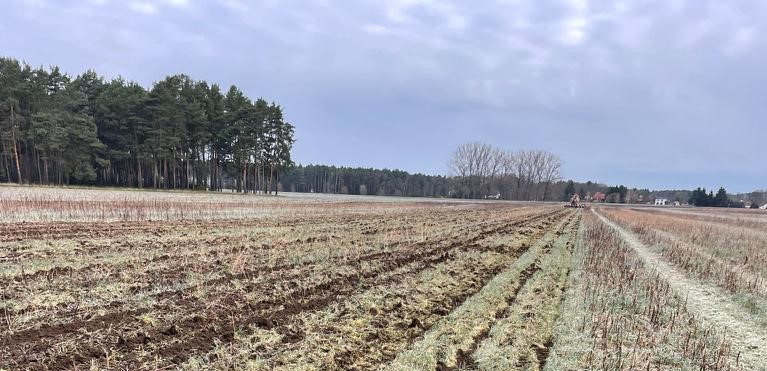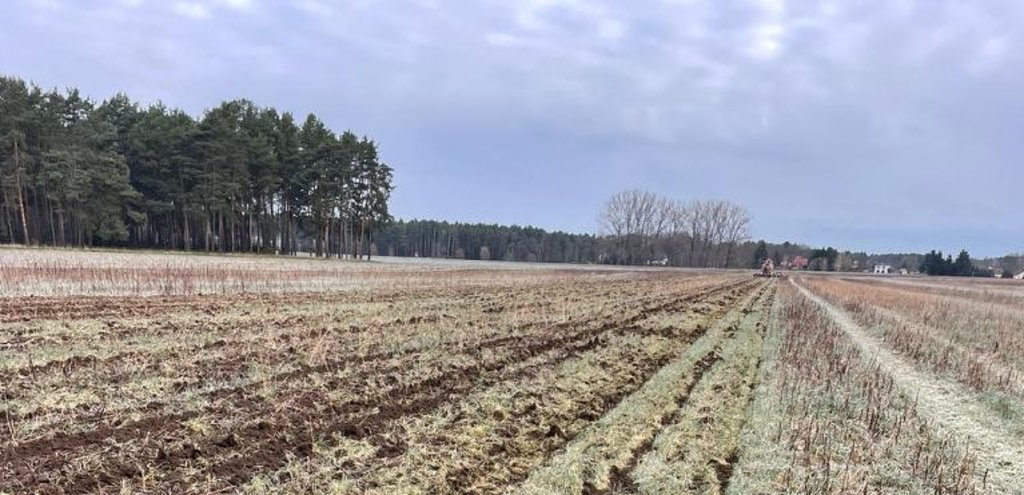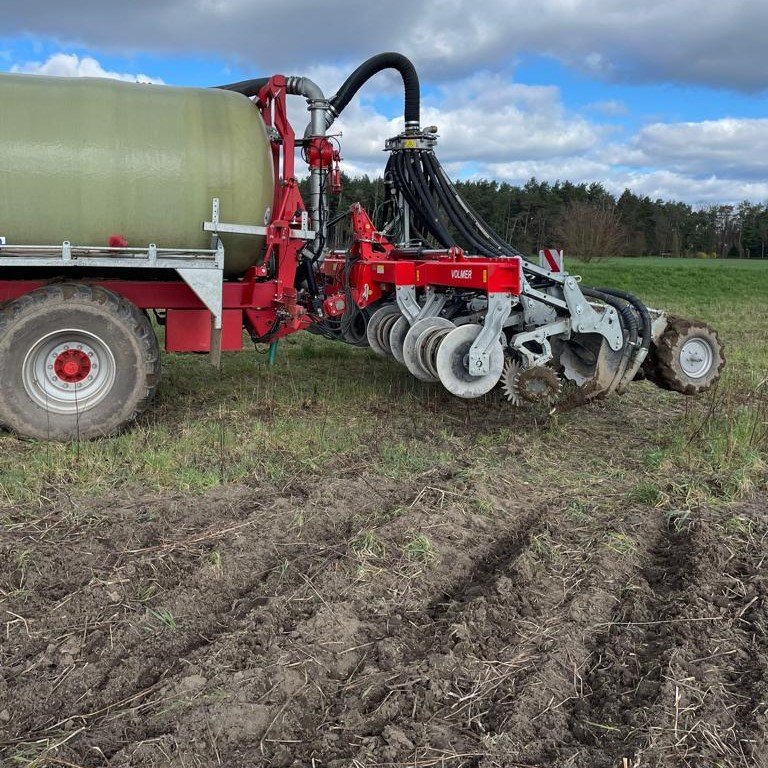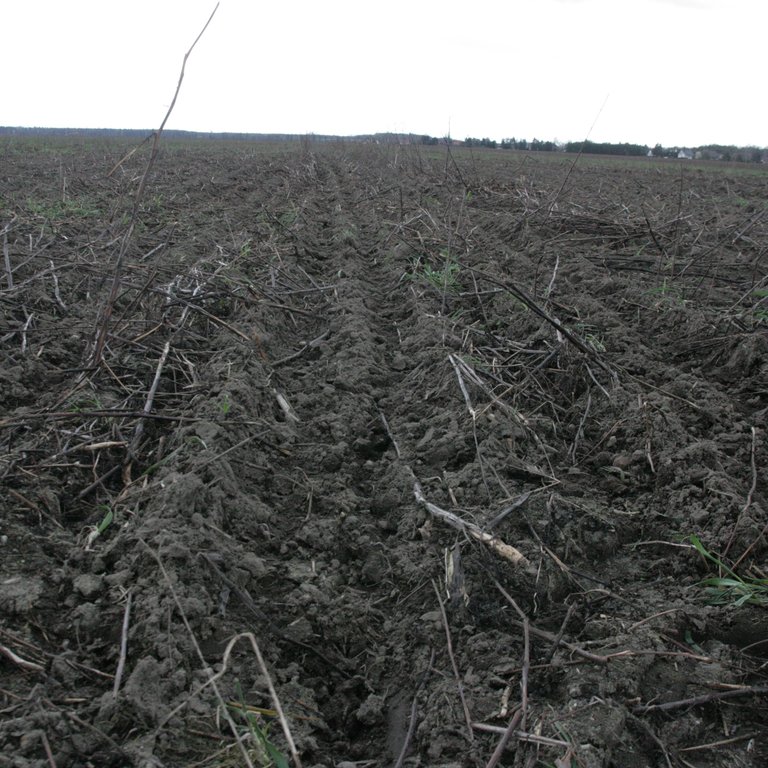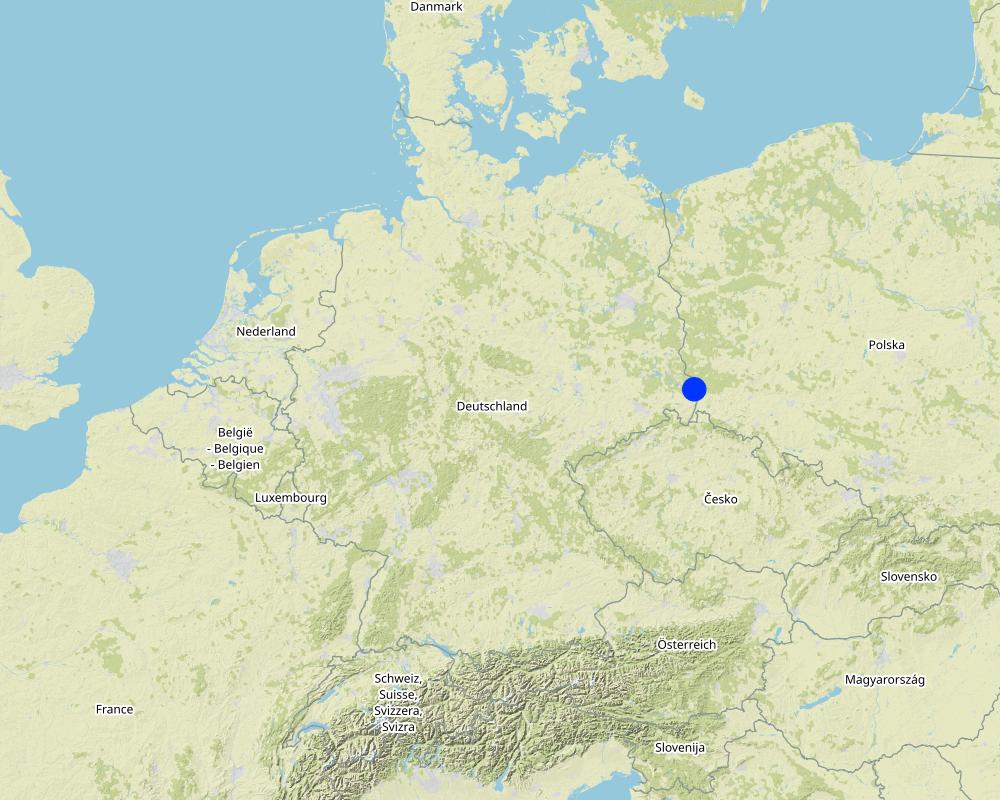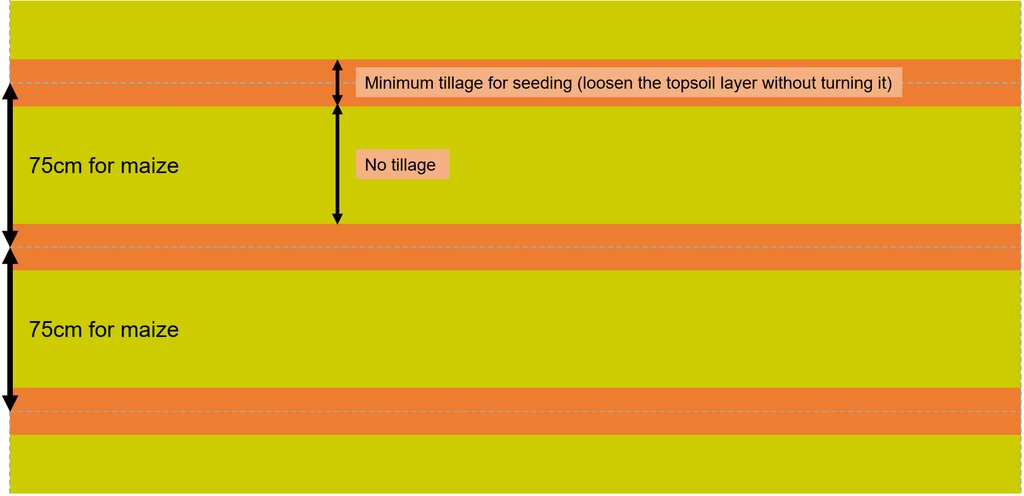Strip-till [德国]
- 创建:
- 更新:
- 编制者: Felix Witing
- 编辑者: Michael Strauch, Mona Pauer
- 审查者: William Critchley, Rima Mekdaschi Studer
Streifenbearbeitung
technologies_6257 - 德国
查看章节
全部展开 全部收起1. 一般信息
1.2 参与该技术评估和文件编制的资源人员和机构的联系方式
SLM专业人员:
SLM专业人员:
有助于对技术进行记录/评估的项目名称(如相关)
OPtimal strategies to retAIN and re-use water and nutrients in small agricultural catchments across different soil-climatic regions in Europe (OPTAIN)有助于对技术进行记录/评估的机构名称(如相关)
Helmholtz Centre for Environmental Research (UFZ) - 德国1.3 关于使用通过WOCAT记录的数据的条件
编制者和关键资源人员接受有关使用通过WOCAT记录数据的条件。:
是
1.4 所述技术的可持续性声明
这里所描述的技术在土地退化方面是否存在问题,导致无法被认为是一种可持续的土地管理技术?:
否
2. SLM技术的说明
2.1 技术简介
技术定义:
Strip-till is a form of precision farming and conservation agriculture that combines minimum tillage in strips with no-till on the remainder of the field. The soil over the whole field is protected by a growing crop or mulch from sunlight, and especially from the direct impact of raindrops by providing permanent soil cover.
2.2 技术的详细说明
说明:
Conservation agriculture includes cultivation systems with minimum tillage or without tillage (no-till). Minimum tillage uses machinery (cultivators, rotary tillers) that only loosen the topsoil layer without turning it, leaving a mixture of bare soil and crop residues from the previous crop/ cover crop on the surface. No-till refers to sowing and fertilizing directly into the plant residues. Strip-till is a hybrid, where only the strip around the seed furrow is minimum-tilled, leaving up to two-thirds of the area under no-till.
Strip-till increases surface roughness, which slows the flow of surface water after heavy rains, improving infiltration rates and particle deposition, thus preventing soil erosion, nutrient losses and degradation of water quality in downstream channels and rivers. The plant residues reduce soil crust formation and decrease evaporation rates (Gangan et al. 2022). The residues also improve biological activity and the build-up of soil organic matter (SOM) and clay-humus complexes. The increased SOM content improves water storage capacity and thus water use efficiency throughout the growing season (Stadler, 2014; Busari et al. 2015).
Strip-till seeding is a precision farming technology that requires a high precision GPS guidance system and specific machinery, such as seed drills to cut through crop residues. The distance beween the strips depends on the cultivated crop. For maize cultivation it is typically 75cm. Strip-till machinery is often heavier than conventional seeding drills because the undisturbed soil is denser and harder. Often a new tractor with more horsepower is needed to compensate for the heavy weights. If mulch seeding is used, grain harvesters equipped with well-designed straw/chaff spreading devices across the full cutting width are required (Corsi & Muminjanov, 2019).
Strip-till also has negative side effects, which are related to the disadvantages of no-till: delayed soil warming, soil compaction, increased disease pressure, and increased weed pressure. Without ploughing, other measures such as selecting fast-growing and effective ground cover species, early high-density seeding, and/or using herbicides are needed to control weeds, especially in the transition period (first 2-3 years) when the seed bank in the soil is well-filled.
In our documented example, the farmer used strip-till on sandy soils (lacking nutrients, with poor water-holding capacity) and combined it with the application of organic fertilizer. Specifically the strip-till seeding of maize was chosen to make efficient use of digestate from a biogas plant. The digestate is applied in the tilled strips (seed bed) providing organic fertilizer for the whole growing season. A winter-killed catch crop was sown before drilling maize. The technology required expensive machinery and equipment, such as a Volmer Strip-Till Culex ML, RTK station and GPS guidance system. However, the costs were recouped through savings in fuel and fertilizer.
2.3 技术照片
2.5 已应用该技术的、本评估所涵盖的国家/地区/地点
国家:
德国
区域/州/省:
Saxony
有关地点的进一步说明:
Uhsmannsdorf (Nieder Horka)
具体说明该技术的分布:
- 均匀地分布在一个区域
如果不知道精确的区域,请注明大致覆盖的区域:
- 1-10 平方千米
技术现场是否位于永久保护区?:
否
Map
×2.6 实施日期
如果不知道确切的年份,请说明大概的日期:
- 10-50年前
2.7 技术介绍
详细说明该技术是如何引入的:
- 通过土地使用者的创新
注释(项目类型等):
The farmer wanted to have a system to effectively incorporate biogas residues.
3. SLM技术的分类
3.1 该技术的主要目的
- 改良生产
- 减少、预防、恢复土地退化
- 适应气候变化/极端天气及其影响
- 创造有益的经济影响
- To effectively incorporate biogas residues.
3.2 应用该技术的当前土地利用类型
同一土地单元内混合使用的土地::
否

农田
- 一年一作
年作 - 具体指明作物:
- 谷物类 - 玉米
- 谷类 - 黑麦
- Winter-killed cover crop (e.g. mustard) before maize
每年的生长季节数:
- 1
采用间作制度了吗?:
否
采用轮作制度了吗?:
是
如果是,请具体说明:
silage maize, rye, rye
3.3 由于技术的实施,土地使用是否发生了变化?
由于技术的实施,土地使用是否发生了变化?:
- 否(继续问题3.4)
3.4 供水
该技术所应用土地的供水:
- 雨养
3.5 该技术所属的SLM组
- 改良的地面/植被覆盖
- 最小的土壤扰动
- 土壤肥力综合管理
3.6 包含该技术的可持续土地管理措施

农艺措施
- A1:植被和土壤覆盖层
- A2:有机质/土壤肥力
- A3:土壤表面处理
- A6:残株管理
A3:区分耕作制度:
A 3.2: Reduced tillage (> 30% soil cover)
A6:对残株管理作出具体说明:
A 6.4:保留
3.7 该技术强调的主要土地退化类型

土壤水蚀
- Wt:表土流失/地表侵蚀
- Wg:冲沟侵蚀/沟蚀

土壤风蚀
- Et:表土流失
- Ed:风蚀风积

化学性土壤退化
- Cn:肥力下降和有机质含量下降(非侵蚀所致)

物理性土壤退化
- Pc:压实
- Pk:熟化和结壳
- Pu:由于其他活动而导致生物生产功能的丧失

生物性退化
- Bc:植被覆盖的减少
- Bh:栖息地丧失
- Bl:土壤寿命损失

水质恶化
- Ha:干旱化
- Hs:地表水良变化
- Hp:地表水水质下降
3.8 防止、减少或恢复土地退化
具体数量名该技术与土地退化有关的目标:
- 防止土地退化
- 减少土地退化
4. 技术规范、实施活动、投入和成本
4.1 该技术的技术图纸
技术规范(与技术图纸相关):
The distance between the strips depends on the cultivated crop. For maize cultivation it is typically 75cm. For other row-crops (e.g. sugar beet) or rapeseed the distance between the tilled strips can be lower.
作者:
Felix Witing
日期:
07/08/2023
4.2 有关投入和成本计算的一般信息
具体说明成本和投入是如何计算的:
- 每个技术区域
注明尺寸和面积单位:
1 ha
其它/国家货币(具体说明):
€
如相关,注明美元与当地货币的汇率(例如1美元=79.9巴西雷亚尔):1美元=:
0.91
注明雇用劳工的每日平均工资成本:
18.70€ per hour
4.3 技术建立活动
| 活动 | 时间(季度) | |
|---|---|---|
| 1. | Equipment purchase | |
| 2. | Installation of precision farming technology (RTK station, GPS guidance system) |
4.4 技术建立所需要的费用和投入
| 对投入进行具体说明 | 单位 | 数量 | 单位成本 | 每项投入的总成本 | 土地使用者承担的成本% | |
|---|---|---|---|---|---|---|
| 设备 | GPS-guidance system | GPS-guidance system | 1.0 | 25000.0 | 25000.0 | 100.0 |
| 设备 | Volmer Strip-till Culex ML | Vomer Strip-till Culex ML | 1.0 | 25000.0 | 25000.0 | 100.0 |
| 设备 | RTK-station | RTK-station | 1.0 | 17500.0 | 17500.0 | 100.0 |
| 技术建立所需总成本 | 67500.0 | |||||
| 技术建立总成本,美元 | 74175.82 | |||||
如果土地使用者负担的费用少于100%,请注明由谁负担其余费用:
Farmer stated that it is complicated to get subsidies. He said: "equipment subsidies are like a lottery".
注释:
There are no details available about the operating life of the machinery - thus no "per hectare per year" calculation can be estimated.
4.5 维护/经常性活动
| 活动 | 时间/频率 | |
|---|---|---|
| 1. | Spreading biogas digestate | March/April |
| 2. | Combined strip-till | April/May |
| 3. | Weed bonitour | June |
| 4. | Crop protection measure | June |
| 5. | Silage | September/October |
| 6. | Transport to biogas plant | September/October |
4.6 维护/经常性活动所需要的费用和投入(每年)
如果您无法分解上表中的成本,请估算维护该技术所需要的总成本。:
-73.0
如果土地使用者负担的费用少于100%,请注明由谁负担其余费用:
80€/ha are covered by the state of saxony, AL_2 Strip seeding/ direct seeding (SMUL Sachsen, 2015)
注释:
According to the farmer, there are few additional costs to maintain the technology, but there are savings in diesel, labor, etc., resulting in total savings of approx. -73€/ha.
It is not possible for external experts (given the information available) to calculate, independently, the annual costs with any reliability.
4.7 影响成本的最重要因素
描述影响成本的最决定性因素:
If the work is done by a contracting company, the costs are 10-20% higher.
5. 自然和人文环境
5.1 气候
年降雨量
- < 250毫米
- 251-500毫米
- 501-750毫米
- 751-1,000毫米
- 1,001-1,500毫米
- 1,501-2,000毫米
- 2,001-3,000毫米
- 3,001-4,000毫米
- > 4,000毫米
指定年平均降雨量(若已知),单位为mm:
739.00
注明所考虑的参考气象站名称:
https://whh-kliwes.de/mapview
农业气候带
- 潮湿的
- 半湿润
Length of growing period (LGP): 209
(https://www.umwelt.sachsen.de/dauer-der-vegetationsperiode-30631.html)
5.2 地形
平均坡度:
- 水平(0-2%)
- 缓降(3-5%)
- 平缓(6-10%)
- 滚坡(11-15%)
- 崎岖(16-30%)
- 陡峭(31-60%)
- 非常陡峭(>60%)
地形:
- 高原/平原
- 山脊
- 山坡
- 山地斜坡
- 麓坡
- 谷底
垂直分布带:
- 0-100 m a.s.l.
- 101-500 m a.s.l.
- 501-1,000 m a.s.l.
- 1,001-1,500 m a.s.l.
- 1,501-2,000 m a.s.l.
- 2,001-2,500 m a.s.l.
- 2,501-3,000 m a.s.l.
- 3,001-4,000 m a.s.l.
- > 4,000 m a.s.l.
说明该技术是否专门应用于:
- 不相关
5.3 土壤
平均土层深度:
- 非常浅(0-20厘米)
- 浅(21-50厘米)
- 中等深度(51-80厘米)
- 深(81-120厘米)
- 非常深(> 120厘米)
土壤质地(表土):
- 粗粒/轻(砂质)
土壤质地(地表以下> 20厘米):
- 中粒(壤土、粉土)
表土有机质:
- 中(1-3%)
如有可能,附上完整的土壤描述或具体说明可用的信息,例如土壤类型、土壤酸碱度、阳离子交换能力、氮、盐度等。:
Eroded gleysol
5.4 水资源可用性和质量
地下水位表:
< 5米
地表水的可用性:
中等
水质(未处理):
不良饮用水(需要处理)
水质请参考::
地表水
水的盐度有问题吗?:
否
该区域正在发生洪水吗?:
否
5.5 生物多样性
物种多样性:
- 中等
栖息地多样性:
- 低
5.6 应用该技术的土地使用者的特征
定栖或游牧:
- 定栖的
生产系统的市场定位:
- 商业/市场
非农收入:
- 收入的10-50%
相对财富水平:
- 平均水平
- 丰富
个人或集体:
- 团体/社区
机械化水平:
- 机械化/电动
性别:
- 女人
- 男人
土地使用者的年龄:
- 中年人
5.7 应用该技术的土地使用者使用的平均土地面积
- < 0.5 公顷
- 0.5-1 公顷
- 1-2 公顷
- 2-5公顷
- 5-15公顷
- 15-50公顷
- 50-100公顷
- 100-500公顷
- 500-1,000公顷
- 1,000-10,000公顷
- > 10,000公顷
这被认为是小规模、中规模还是大规模的(参照当地实际情况)?:
- 大规模的
注释:
2500 ha
5.8 土地所有权、土地使用权和水使用权
土地所有权:
- 个人,未命名
土地使用权:
- 租赁
- 个人
用水权:
- 社区(有组织)
土地使用权是否基于传统的法律制度?:
否
5.9 进入服务和基础设施的通道
健康:
- 贫瘠
- 适度的
- 好
教育:
- 贫瘠
- 适度的
- 好
技术援助:
- 贫瘠
- 适度的
- 好
就业(例如非农):
- 贫瘠
- 适度的
- 好
市场:
- 贫瘠
- 适度的
- 好
能源:
- 贫瘠
- 适度的
- 好
道路和交通:
- 贫瘠
- 适度的
- 好
饮用水和卫生设施:
- 贫瘠
- 适度的
- 好
金融服务:
- 贫瘠
- 适度的
- 好
6. 影响和结论性说明
6.1 该技术的现场影响
社会经济效应
生产
作物生产
注释/具体说明:
Effective use of the organic fertilizer (biogas digestate) and improvement of soil quality (sandy soils).
作物质量
生产故障风险
注释/具体说明:
Increased water holding capacity on the long term.
收入和成本
农业投入费用
注释/具体说明:
Can efficiently use organic fertilizer (biogas digestate).
农业收入
注释/具体说明:
Increase due to savings of diesel and labor.
收入来源的多样性
工作量
注释/具体说明:
Fewer working operations.
生态影响
水循环/径流
地表径流
注释/具体说明:
Increased infiltration rates
土壤
土壤水分
注释/具体说明:
Improved soil moisture due to increased infiltration and less transpiration (improved soil cover)
土壤覆盖层
土壤流失
土壤压实
土壤有机物/地下C
生物多样性:植被、动物
害虫/疾病控制
注释/具体说明:
Due to combination with winter-freezing cover crops.
减少气候和灾害风险
干旱影响
对现场影响的评估(测量)进行具体说明:
The assessment is based on the response of the interviewed farmer and not based on on-site measurements.
6.2 该技术的场外影响已经显现
水资源可用性
下游洪水
注释/具体说明:
Reduced due to less surface runoff.
地下水/河流污染
注释/具体说明:
Reduced due to less surface runoff and efficient application of fertilizers.
风力搬运沉积物
注释/具体说明:
Reduced due to improves soil cover.
对场外影响(测量)的评估进行具体说明:
The assessment is based on expert judgement of the compiler and not based on local measurements.
6.3 技术对渐变气候以及与气候相关的极端情况/灾害的暴露和敏感性(土地使用者认为的极端情况/灾害)
渐变气候
渐变气候
| 季节 | 增加或减少 | 该技术是如何应对的? | |
|---|---|---|---|
| 其他渐变气候 | Changing weather conditions | 增加 | 好 |
气候有关的极端情况(灾害)
气候灾害
| 该技术是如何应对的? | |
|---|---|
| 热浪 | 好 |
注释:
The changing weather conditions lead to a higher motivation and higher willingness to invest.
6.4 成本效益分析
技术收益与技术建立成本相比如何(从土地使用者的角度看)?
短期回报:
消极
长期回报:
积极
技术收益与技术维护成本/经常性成本相比如何(从土地使用者的角度看)?
短期回报:
中性/平衡
长期回报:
积极
6.5 技术采用
- 1-10%
在所有采用这项技术的人当中,有多少人是自发的,即未获得任何物质奖励/付款?:
- 91-100%
注释:
The farmer adopted the technology without receiving subsidy for the machinery and precision farming technology. However, with the most recent subsidy systems it is possible to get hectare-based payments for applying strip-till.
6.6 适应
最近是否对该技术进行了修改以适应不断变化的条件?:
否
6.7 该技术的优点/长处/机会
| 土地使用者眼中的长处/优势/机会 |
|---|
| Economically beneficial. |
| Savings of operations in sowing and tillage. |
| Higher soil moisture, improved water-use-efficiency through the whole growing season. |
| 编制者或其他关键资源人员认为的长处/优势/机会 |
|---|
| Less erosion (less bare soil). |
| Higher water infiltration rates (more macro- and mesopores due to roots and improved biological activities). |
| Improved soil health and quality. Plant residues/cover crops increase biological activity, such as the presence of earthworms that digest plant residues into clay-humus-complexes, improving soil structure. |
| Greater planting time flexibility. The new crop can be sown as soon as the previous crop is harvested and weather conditions are suitable. |
6.8 技术的弱点/缺点/风险及其克服方法
| 土地使用者认为的弱点/缺点/风险 | 如何克服它们? |
|---|---|
| Component failure of the technology: it is quite susceptible to interference during data transmission. | Thus, in Germany, for example, better grid development is needed. |
| 编制者或其他关键资源人员认为的弱点/缺点/风险 | 如何克服它们? |
|---|---|
| Increased weed pressure. | However, this often occurs only in the first few years. Planting of cover crops can suppress weeds. |
| Increased disease pressure. | Can be overcome by diverse crop rotation without direct repetitions (e.g. wheat-wheat, or maize-maize). Grinding of residues for faster decomposition. |
| Delayed soil warming- | Adjustment can include underfoot fertilization as well as injection fertilization. |
7. 参考和链接
7.1 信息的方法/来源
- 实地考察、实地调查
1
- 与土地使用者的访谈
1
- 根据报告和其他现有文档进行编译
(现场)数据是什么时候汇编的?:
16/03/2023
7.2 参考可用出版物
标题、作者、年份、ISBN:
Corsi, S. and Muminjanov, H. (2019): Conservation Agriculture: Training guide for extension agents and farmers in Eastern Europe and Central Asia. Rome, FAO.
可以从哪里获得?成本如何?
https://www.fao.org/sustainable-agricultural-mechanization/resources/publications/details/ar/c/1195731/
7.3 链接到网络上的相关信息
标题/说明:
Busari et al. (2015): Conservation tillage impacts on soil, crop and the environment. International Soil and Water Conservation Research 3(2)
URL:
https://doi.org/10.1016/j.iswcr.2015.05.002
标题/说明:
Stadler (2014): Mulchsaat zu Mais- das „Wie“ entscheidet. LfL
URL:
https://www.lfl.bayern.de/mam/cms07/iab/dateien/mais_2-2014_stadler_mulchsaat2.pdf
标题/说明:
Gangan et al. (2022): Effect of raindrop splashes on topsoil structure and infiltration characteristics. CATENA 212
URL:
https://doi.org/10.1016/j.catena.2022.106040
标题/说明:
Schmidt et al. (2001): Conservation tillage - A new strategy in flood control. 287-293. In J. Marsalek et al.: Advances in urban stormwater and agricultural runoff source controls. quoted in: LfULG- Landesamt für Umwelt; Landwirtschaft und Geologie: Direktsaat.
URL:
https://www.landwirtschaft.sachsen.de/direktsaat-19689.html
标题/说明:
SMUL Sachsen (2015): Förderperiode 2014-2020- Art. 28 der Verordnung (EU) Nr. 1305/2013 - Richtlinie Agrarumwelt- und Klimamaßnahmen (RL AUK/2015)-Sächsisches Agrarumwelt- und Naturschutzprogramm (AUNaP)
URL:
https://www.smul.sachsen.de/lfulg/download/AUK-Massnahmen-Ueberblick.pdf
链接和模块
全部展开 全部收起链接
无链接
模块
无模块


